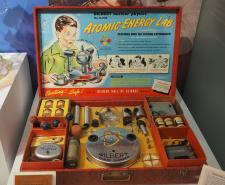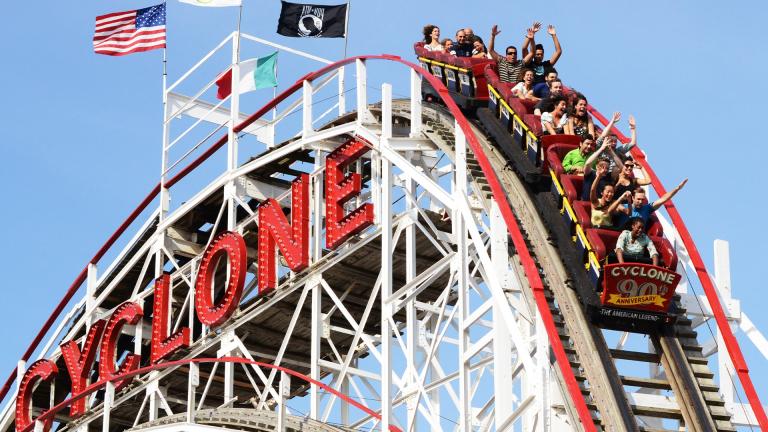
Read more about Modern History

The origins of the modern fairground may well stretch back to the great fairs of medieval England, which were centred more on trade and commerce but developed to include leisure attractions over time. Today, they’re all about fun and thrill-seeking.
But while the emphasis is firmly on having a good time, things don’t always go to plan. Accidents do occur, and in the worst scenarios, a malfunctioning fairground ride can even result in death, as has happened on several occasions.
The team at Sky HISTORY have been investigating some of the most dangerous fairground attractions to have ever been built. Thankfully, safety standards are much higher today, but things weren’t always that way! Read on to find out more.
Hazardous History With Henry Winkler starts Monday 17 November 10pm on Sky HISTORY and HISTORY Play.
In 1895, entrepreneur and fairground pioneer Paul Boyton opened one of the first theme parks at Sea Lion Park on Coney Island in New York. Its star attraction was the Flip Flap Railway, which featured one of the first looping rollercoaster tracks in the USA.
The ride had been developed by Lina Beecher and tested in Toledo, Ohio, several years prior, with no adverse effects or accidents reported. However, it soon became clear that the perfectly circular loop, alongside its relatively small diameter (25ft, or 7.6m), exerted dangerously high pressures on its riders.
While there is some debate as to the exact measurements, it’s believed that the G-force generated during the ride was akin to that suffered by Spitfire pilots in WWII, leading to many instances of neck injuries and people falling unconscious during the ride.
For this reason, it was more common that people would pay to watch others ride the Flip Flap Railway than go on it themselves, and when the Park folded in 1902, the Railway flopped with it.
Coney Island wasn’t destined to remain fairground-free for long, however. 1907 saw the inception of the Rough Riders rollercoaster. Based on the exploits of then-president Theodore Roosevelt (a distant relative of the legendary Franklin D Roosevelt and leader of the First US Volunteer Cavalry in the Spanish-American war ten years’ prior), the coaster was themed on that conflict.
Unlike most other rides of the time, the Rough Riders was not propelled by gravity alone, but rather by an electric rail – in the much the same way that subway cars are. As such, each car was controlled manually by a park employee, which meant that they were in charge of how fast it went.
This was a recipe for disaster. Insufficient braking for corners and drops meant that 16 riders were thrown from their carriage in 1910, with four dying as a result. Incredibly, this incident was not enough to get the ride shut down, and history repeated itself five years later.
On that occasion, four more passengers (plus the operator) were thrown out of the car and through the flimsy metal railing at its side due to reckless driving. Three fell 30ft (9.1m) to their deaths, while an onlooker was hospitalised after being struck by the operator. The ride was, unsurprisingly, shut down the following year.
Another Coney Island rollercoaster makes the list, though it should perhaps be qualified that this one – first built in 1927 at a cost of $100,000 (some $1.8 million by today’s standards) – has been operational for almost a century.
The Cyclone was constructed on the same land that used to house the original Switchback Railway. After a clean bill of health spanning nearly 60 years, the ride suffered its first fatality in 1985 when a passenger stood up mid-ride and hit his head on a support beam.
Three years later, a maintenance worker at the park was riding the Cyclone during his lunch break when he fell 30ft (9.1m) to his death. Again, eyewitnesses reported that he had been standing on the ride at the time. A further tragedy struck in 2007 when a man suffered crushed vertebrae in his neck from the ride, eventually succumbing to his injuries in hospital.
Despite these three incidents, and two more in which people have claimed to have been injured from riding the Cyclone (in 2008 and 2015), it remains open to this day and is a singular reminder of Coney Island’s illustrious past.
Meanwhile, two of the deadliest accidents to ever occur on fairground rides took place on two rollercoasters sharing the same name, albeit separated by over 4,000 miles and 40 years.
Firstly, the Big Dipper of Krug Park in Omaha, Nebraska was the site of a terrible tragedy in 1930, when all four of its cars jumped the track and plummeted 35ft (10.7m) to the ground below. Four people were killed, with 19 more suffering serious injuries.
That’s the most serious fairground mishap to have occurred on US soil, but an even more devastating incident took place in the UK in 1972. While Blackpool might be the most famous of British theme parks – and is also home to a Big Dipper – this one occurred at Battersea Park in London.
Before the ride had cleared its first incline, the lift mechanism malfunctioned and all the cars careened backwards down the track, derailing at a bend. Five children were killed, while 13 others were injured.
Accidents can happen in any industry, of course, but the high-stakes and high-profile nature of theme park attractions means that these will invariably claim huge headlines. Nonetheless, people still keep coming back for more, despite (or perhaps in part because of) this dangerous element.
Want more stories like this? Subscribe to the Sky HISTORY newsletter today. Every week, you’ll receive fascinating history stories and insights delivered straight to your inbox. Whether you’re interested in WW2, popular culture, mysteries or sport, it’s the newsletter for you.